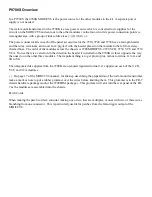
Page 5
SKU 94190
For technical questions, please call 1-800-444-3353.
Important Considerations About Compression Loss Testing
1.
There will always be some compression loss past piston rings, even in a new
engine. You will never see a 0% compression loss, and this lost pressure
should be audible at the oil dipstick port.
2.
If the Leakage Gauge shows very high or 100% compression loss, the cylinder
may not be at Top Dead Center (TDC) on the compression stroke. Check to
be sure the cylinder is at TDC, so the valves are closed. Reference your
vehicle owner’s manual for instructions on how to do this.
3.
A “good” reading will show compression loss of all cylinders at about the same
rate. A large difference of 15% to 30% comparing one cylinder to the others
indicates a problem.
4.
Leakage rate readings may vary by up to 10% when taking repeated readings
of the same cylinder. Piston position and engine temperature can cause
variable readings. Take several readings and average the results for a recorded
reading for each cylinder.
5.
Diagnosing an engine problem with this tool involves using a listening device
(not included). A length of hose or a mechanic’s stethoscope are suggested.
6.
The lower the sound pitch of escaping pressure indicates a larger leak. Small
leaks will typically make a higher pitched sound.
7.
If the vehicle has multiple problems, the Cylinder Leakage Tester may show
only the most pronounced problems. A large problem may overwhelm a
smaller problem during testing.
Operation
IMPORTANT NOTE: Be sure the Regulator Knob (9) is turned fully counter-
clockwise before connecting the Cylinder Leakage Tester to a pressurized
air source. Failure to do so may result in damage to the tool.
NOTE: The engine must be at normal operating temperature for accurate testing.
Start the engine and let it warm up to normal operating temperature, then turn it off
for testing.
CAUTION: Always run an engine in a well ventilated space. Running en-
gines produce Carbon Monoxide, a colorless, odorless gas which can cause
serious personal injury or death if inhaled.


























